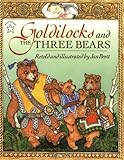Lesson 2: The Rule of Three
Lesson Plan
Goldilocks and the Three Bears | 880L

- Learning Goal
- Explain that fairy tales often have objects, characters, and events that come in groups of three.
- Identify objects, characters, and events that come in groups of three in fairy tales.
- Duration
- Approximately 50 minutes
- Necessary Materials
- Provided: Unit Example Chart, Independent Practice Worksheet
Not Provided: Goldilocks and the Three Bears by Jan Brett chart paper, markers
-
Teacher Modeling

will explain to students that another characteristic of fairy tales is that objects, characters, and events often occur in groups of three. This is a characteristic of fairy tales because story tellers from the past believed that three was a lucky number. To identify sets of three in the text, I will look for explicit evidence in the text that tells me that there are three of something. Other times, I will have to pay attention to repetition in the text and count for myself whether there are three similar objects, characters, or events. I will model how to identify groups of three in a familiar fairy tale— Rumpelstiltskin (from Lesson 1). For example, say "the miller’s daughter was given three rooms full of hay to spin into gold. The text did not tell me that there would be three rooms. I had to listen for the repetition (the same thing happened each day) and count for myself. Also, the text explicitly told me that Rumpelstiltskin gave the miller’s daughter three days to guess his name." I will add Rumpelstiltskin to my Characteristics of Fairy Tales Chart (Example Chart is provided in Unit Teacher and Student Materials) because it is a fairy tale with examples of groups that come in three.
-
Think Check
Ask: "How do I identify groups of three in a fairy tale?" Students should answer that you can identify explicit information in the text that tells you that there are three objects, characters, or events. Other times you have to pay attention to repetition in the text and count for yourself to find out whether there are three objects, characters, or events.
-
Guided Practice

will read the first part of Goldilocks and the Three Bears by Jan Brett, and discuss the objects, characters, and events that are in groups of three in the text. For example, the text explicitly tells the reader that there are three bears, but we have to count the number of bowls to discover that there are three of those too. We will reflect that we have identified groups of three in the fairy tale, and add the title to our chart.
-
Independent Practice

will identify other groups of three in Goldilocks and the Three Bears as the teacher continues to read the rest of the fairy tale. You will explain on your worksheet that fairy tales often have groups of three objects, characters, and events. (Independent Practice Worksheet is provided.)
Texts & Materials
Standards Alignment
(To see all of the ReadWorks lessons aligned to your standards, click here.)

